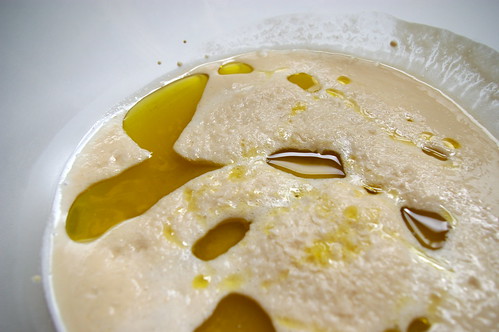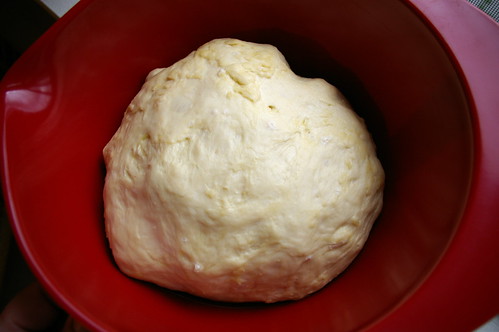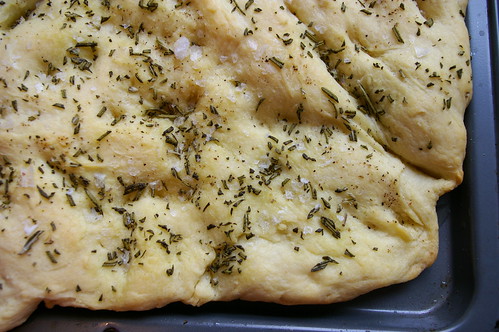There is a restaurant in Victoria that I am almost incapable of avoiding during any visit to that lovely little city. Pagliacci’s was the scene of more than a few fun nights out with friends while we procrastinated on assignments from UVic and has subsequently become a place that speaks to me of good memories along with good food. I am positively addicted to their dish called the Prawn Broker (spinach pasta, prawns and cashews in a coconut-curry sauce) and will admit with no hesitation that I always order the full size — which is far too big for one sitting — so that I can enjoy just a little bit more later. (Side note: Every few weeks I search the Internet in the apparently feeble hope that the recipe will magically appear. Future blogging may include attempts to recreate the thing myself. Success is not guaranteed.)
But, while the Prawn Broker is my main dish of choice, I could very easily live on the baskets of focaccia set on the table shortly after ordering. Chewy, thickly crusted, salty. I have no idea what magic lies in that recipe which leads to such bready perfection. I can only presume part of the reason is a thick dousing of olive oil. But there are no apparent herbs or crystals of salt to hint at what else goes into this recipe.
My pursuit of focaccia perfection began about a year ago when I bought (finally!) a handheld mixer. (Friends were unsurprisingly baffled when I made cookies without a mixer, using my own arm strength to cream butter and sugar together.) To my delight, it came with two dough hooks, which opened up the world of bread baking. Okay, so, it’s a pretty limited world at this point, but nevertheless. Since then, I’ve tried to make focaccia a few times, but found it lacking. Where i wanted dense and chewy, these attempts were light and, at one point, crumbly (don’t try to make bread with all-purpose flour, apparently). The top was delicious, owing mostly to a liberal sprinkling of flaky Maldon salt, chopped rosemary and a few generous glugs of olive oil that filled in the divots I had dimpled across the surface of the pale dough. But it wasn’t the best ever.
Baking bread, I fear, is one of those arts that is being lost in my generation. The reason I never made bread before was that, frankly, kneading baffles me. I never seem to get the dough to come together and never seem to have the patience to keep going. Growing up, my mum often made homemade bread and I would “help” but eventually she would take over the kneading. (This is why the dough hooks were such a welcome addition to my mixer.) But also lost is the knowledge on how to affect the outcome of recipes.
I was sharing the focaccia dilemma with my friend Shelley one afternoon when she asked me a few questions about the recipe and I mentioned that it called for the dough to rise three times. Well, she said, that explained why it was so light. Fewer chances to rise = denser dough. Of course, now that she has said that, it makes perfect sense. But since I didn’t know much about baking bread, it didn’t occur to me to play around with the recipe. Of course, now that i *do* know, I’m making it a mission to make the best focaccia possible.
This time I tried a different recipe, but modified it slightly by not letting it rise a second time in the hope it would produce a chewier end result. It definitely did. But it’s still not as good as the bread from Pagliacci’s and I felt the focaccia overall could have used some more flavour. The top was pretty good, though, owing I’m sure to the generous amount of salt, olive oil and chopped rosemary.
And so, the pursuit continues.
Here is the latest attempt. It comes from the fabulous Rebar Modern Food Cookbook, which, as previously mentioned, I bought only for a salad dressing recipe. In this case, however, I didn’t let it rise a second time and I didn’t bother with the garlic, as I find it very hard to keep it from burning. There are few tastes worse than burnt garlic. This is the recipe as printed.
Rosemary Garlic Foccacia
- 1 3/4 cups warm water
- 1 tbsp. traditional baking yeast
- 1/2 tsp. sugar
- 2 tsp. salt
- 1/4 cup olive oil
- 4 cups unbleached flour
Topping
- 4-6 garlic cloves, minced
- 4 tbsp. olive oil
- 2 tsp. coarse salt
- 2 tbsp. chopped rosemary
- cracked black pepper
In a large mixing bowl, combine the warm water, yeast and sugar. Let the mixture sit until it foams. Stir in salt and olive oil, then start adding flour, one cup at a time, beating well with a wooden spoon. (Yeah, I used my mixer here.) When you can no longer stir, turn the dough out on a floured surface and knead in the remaining flour. Knead the dough until smooth and elastic, sprinkling just enough flour on the counter to prevent sticking.
Form the dough into a ball and place a large, lightly oiled bowl. Cover with a clean, damp cloth and set the bowl in a warm, draft-free spot. Let rise until doubled in bulk (1 – 1 1/2 hours). Punch the dough down and let it rise again until doubled.
Pre-heat the oven to 350F. Place the dough on a well-oiled 12″x16″ baking sheet with 1/2″ sides. Gently stretch the dough to roughly fit the dimensions of the pan. Drizzle the surface with olive oil and spread the minced garlic over the entire area. Sprinkle chopped rosemary evenly on top, followed by coarse salt. Finish with cracked pepper. Using your fingertips, gently poke indentations over the entire surface. It should appear dimpled and rustic-looking. Let rise again for about 15 minutes, or just until it puffs up slightly.
Place the loaf in the center rack of the oven. Bake for 20 minutes, rotating the pan halfway through. The garlic should be lightly golden. Be careful not to over bake. Serve warm.





